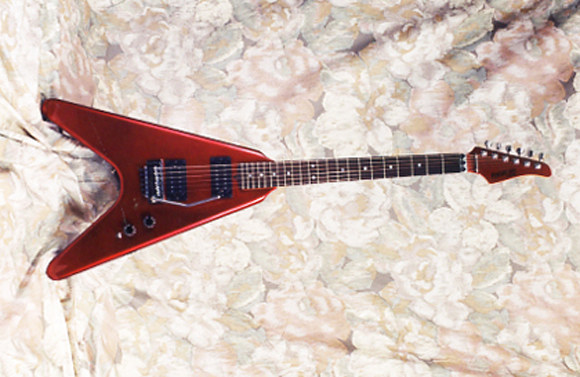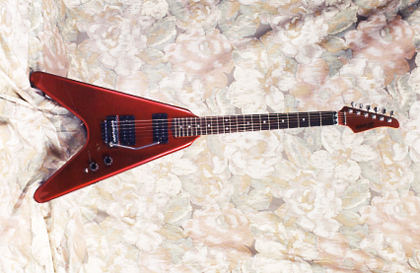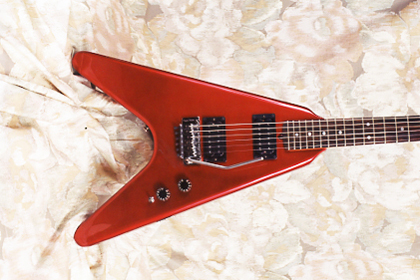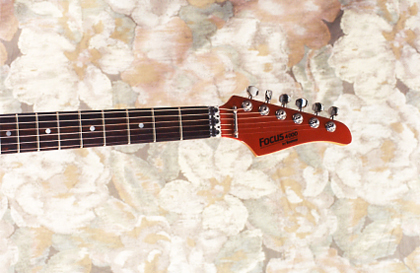
I love ironies, those unexpected little twists and turns that make you smile. And, if there’s a guitar story that’s full of more irony than that of Kramers guitars, I don’t know about it. That’s why I love guitars like this 1983 Kramer Focus K4000. It’s a knock-off of a Kramer guitar, but a copy of a Kramer made by Kramer itself. Or, actually, a copy of Kramer’s “copy” of a Gibson Flying V! You almost need a scorecard! You see the potential for ironies here…
For guitar enthusiasts with a short memory, Kramer’s Focus and Striker series guitars are a cause of some confusion and, to be sure, there have been some unscrupulous people who’ve taken advantage of this fact. Kramer, as you recall, began back in 1976 with the novel idea of building guitars with aluminum necks, sort of “improved” Travis Beans. Their guitars were kind of a niche item, well made and generally well-received by players, but certainly no threat to Gibson or Fender. Stanley Jordan, the jazz tapper, was probably their most famous player. Kramer had a little more success when it introduced the small-bodied, headless Duke guitars in the early 1980s. Andy Summers of The Police was big with his headless Steinberger guitar so the Duke had a following.

Vintage 1983 Kramer Focus K4000 Electric Guitar
Kramer began to move away from the aluminum neck concept in around 1981 with the introduction of wood neck options. Actually, it’s around the subject of necks that one of the ironies swarm. Kramer designed but did not make its aluminum necks. They were sourced out to an aluminum fabricator, which makes perfect sense and is in no way unusual, especially when a novel material is involved. So, when Kramer began to use wooden necks, they logically turned to other vendors to obtain them. There were a variety of neck providers for Kramer over the years, but two of note where ESP, a Japanese company, and La-Si-Do, a Canadian company. The irony is that these were put on guitars that today are known as the “American” Kramers! By the way, I don’t know if Kramer made the bodies for its aluminum-necked guitars, but almost all—if not all—bodies on the wooden-neck American Kramers were made by a company called Sports.
Ironically, once Kramer began moving away from its unique original premise and capitulated to the common wooden neck, it began to take off phenomenally. Of course, having an endorsement of Edward Van Halen didn’t hurt. Nor did the early ‘80s infatuation with what would become known as the “Superstrat.” The Kramer Pacer (1983), along with Dean’s Bel Aire, both vie for the status as the first production Superstrats, available in versions with humbucker/single/single pickups and the soon-to-be-ubiquitous locking vibrato system.

Vintage 1983 Kramer Focus K4000 Electric Guitar
By 1983 Kramer was doing well enough to consider expanding with some budget lines made in Asia. It had already sourced necks from ESP in Japan, as well as offered ESP’s Flicker vibrato system as an option. Thus debuted the Kramer Focus line, made in Japan, in 1983. This was followed in 1984 by the Kramer Striker line, made in Korea.
The initial Kramer Focus line consisted of copies of the Baretta, Pacer, and early Vanguard models, plus Kramer’s early Fender-style bass and their thinner Stagemaster bass. At some point early on a copy of the Kramer Voyager joined the line.
Seen here is what’s probably a fairly rare early Focus by Kramer K4000 made in Japan. (As of yet I don’t believe the Japanese manufacturer has yet been identified, but these feel a lot like Chu-Shin.) Early Kramer Vanguards were modeled after the Flying V (1981-84). In 1985 the design changed to be more like the Randy Rhoads V made by Jackson, with a shortened lower wing.

Vintage 1983 Kramer Focus K4000 Electric Guitar
This is a really nice guitar, made nicer by the fact that it was found as unsold “New Old Stock” in the basement of the old 8th Street Music in Philadelphia. We know this is early because it has the “classic” headstock, later changed to droopy “bananas.” These are early unlabeled pickups, possibly Gotoh, but who knows? The double-locking Floyd Rose is likewise early, without fine tuners.
I think this is a very early 1983 Focus. While the exact sequence is a bit confusing, the original American Vanguard “Flying V” model was discontinued in 1984. It appears that in 1984 the Focus 4000 became a Pacer copy. In 1985, the Focus 4000 changed to the new Randy Rhoads shape.
In yet another irony, a lot of Kramer Focus guitars have been parted out. Early Focuses had a Focus by Kramer logo, but later models moved the Focus ID to the neck plate. Apparently quite a number of these, as well as Focus bodies, have been sold as “genuine American” Kramer parts. However, as we’ve seen, all but a few (made by Sports) Kramer wooden necks weren’t American-made in the first place!
In one more irony, the Kramer brand name is now owned by Gibson, the company that Kramer copied for this guitar! The name was owned by Henry Vaccaro, one of the original Kramer principals. He wanted to relaunch the Kramer brand in the late 1990s. He needed money so he sold the Kramer brand and model names to Gibson. Gibson subsequently released a line of very inexpensive Asian-made Kramers. Ironically, Gibson recently announced some upscale “copies” of Kramer’s legendary Pacer guitars! One last irony (I promise): I’m writing this essay about the irony of Kramers for Eastwood guitars, which specializes in producing “copies” of cool designs from the past. But I guess since Gibson has just reissued the Pacer, there won’t be an Eastwood Pacer any time soon!
Michael Wright, The Different Strummer, is a collector and historian whose work is featured in Vintage Guitar Magazine.

Orginal Kramers are crazy cool and becoming once again collectable. At one time, you could pick up just about an Kramer for 50 bucks. I have two, a Kramer Classic strat clone, and a Night Swan, both stellar guitars.
THe fact you could get them so cheaply after the demise of Kramer meant that lots of collections are out there. I still pull mine down from time to time and have gigged them as recently as a few months ago for grins. Still loud and proud and I don’t even belong to the Kramer cult…
IMHO the 3 best deals out there for vintage guitars and basses right now are the Kramer, the Aria, and the Washburn. Those 3 brands cranked out a ton of REALLY cool designs in the 70s and 80s and can be found sitting in the corner of many a pawnshop waiting to be picked up for a song. While you can get lucky occasionally and score a sweet Korean Squire or a great sounding Epiphone those 3 brands i just named had the most consistent quality for the longest time while staying low enough on most radars to not have the prices jacked up just because they are old.
I have one!
I have an ’83 Bel Aire — tried to sell it and people don’t even understand what it is…
1985 Kramer Striker 400st Flying V… had this since I was 9yrs old..
I had one of those back in the 80’s. The Floyd Rose on mine didn’t yet have the fine tuning screws on the bridge so it was hard to tune once you screwed down the nut.
I had the exact one like that, unfortunately I had to sell it when I was broke in college back in 1985. Do you know of any for sale like this?
Thanks for bringing back a memory.
I have this same guitar, with the same shaped headstock. Mine is in black, with cream-colored pickup covers. It has a Floyd Rose, with fine-tuners. Does anybody know how many of these were made? It’s been a great guitar for me, my main rig for nearly 30 years..
Judging by the non-fine-tuner Floyd Rose and the long distance between the locknut and the string retainer, this was built at the Matumoku factory in Japan. There will be a Kramer neckplate with no serial number. The Matsumoku Focus had the black decal on the headstock. The ESP made Focus had gold decals. If you removed the pickups, they should have MMK 45 underneath.
From my research, this is the second run of the beak heads Focus. The first and third run beak-head Focus were made by ESP.